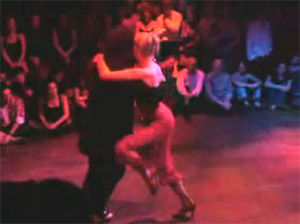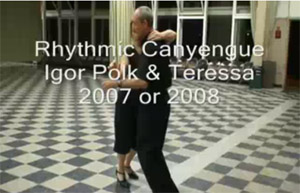Pictures:
I take liberty of putting some of my own pictures here along with Masters:Donna and Igor:
(photo Marty Sohl)
This is a static apilado position: we lean to each other, creating a triangle. Since my feet are together, I can start movement from any leg easy. Our knees are bend a little: they are immediately ready for action.
Teressa and Igor show Apilado in dynamic: 
(photo Linda Ayre)
Do you see how during a step our standing legs are stretched in accordance with distribution of forces? Triangle is preserved.
One more: 
- can one explain theoretically what is going on? I can not.
This is Marta and Manolo: 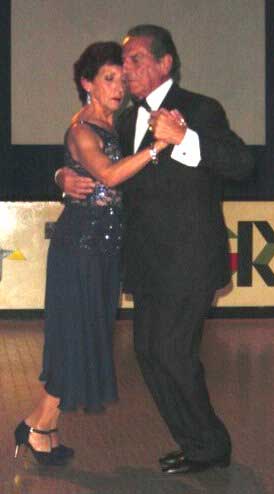
- note the slightly bend knees! It is to unlock them, it makes legs very alert and ready, and lowers the center of gravity of unified bodies to make it more stable. And not only, it is like in a bike, this thing which holds the front wheel, it is bend. It stabilizes the couple in side-to-side direction: their feet are together, essentially, each of them is standing on one foot only.
Gloria and Eduardo Arquimbau ( sorry, too small, I know):
 - Apilado in dynamic: leading to a cross. She puts her foot in the place where lean is preserved! He is just stepped on the strighten right leg, and will move his body in the next millisecond a little further forward to put her on the crossing foot. For the man, this is not a static position, but a dynamic one: passing the point where his body are vertical. In a millisecond he will be leaning toward her! She is never vertical. At least in simple steps.
- Apilado in dynamic: leading to a cross. She puts her foot in the place where lean is preserved! He is just stepped on the strighten right leg, and will move his body in the next millisecond a little further forward to put her on the crossing foot. For the man, this is not a static position, but a dynamic one: passing the point where his body are vertical. In a millisecond he will be leaning toward her! She is never vertical. At least in simple steps.
One more:
 - forward step in Apilado position. Note the woman lean and the man's straight stepping leg!!! This is a picture of bodies in dynamic. They actually move at the moment the picture was taken with high speed. You can observe it yourself on my Gloria and Eduardo CD videos. Straight stepping front leg helps to stop at any moment effectively absorbing all extra energy.
- forward step in Apilado position. Note the woman lean and the man's straight stepping leg!!! This is a picture of bodies in dynamic. They actually move at the moment the picture was taken with high speed. You can observe it yourself on my Gloria and Eduardo CD videos. Straight stepping front leg helps to stop at any moment effectively absorbing all extra energy.
Note: his leg is on the floor already, and hers not! And on the previous picture too! That is the way she follows him!
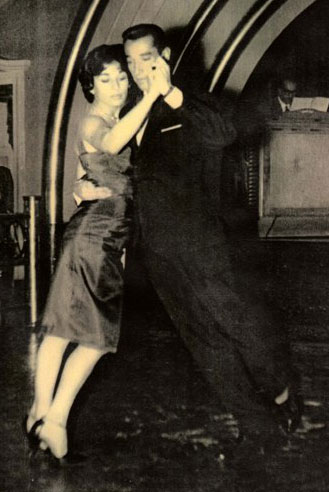 - Orlando Paiva Sr.
- Orlando Paiva Sr.
Questions?
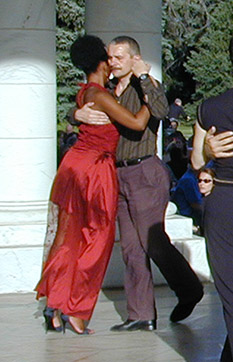 This woman in red is one of the best dancers I have ever experienced. A natural tango dancer. Look at her, she is dancing with Oleh from Denver at this picture, not with me.
This woman in red is one of the best dancers I have ever experienced. A natural tango dancer. Look at her, she is dancing with Oleh from Denver at this picture, not with me.
"She is not on her own balance!"
Yes, she is. Her axis is not vertical, but balance and vertical axis are two very different things commonly misunderstood. Balance is not verticality. Balance is the ability to maintain a position.
In Apilado Position she is very much responsible for maintaining the balance as well as the man. But exactly the same can be said about open embrace! It is especially felt in molinetes, when unified axis of rotation of the couple if vividly present. If she is not maintaining the shared axis of rotation, the couple falls apart! Her own axis in open embrace is mostly vertical, yes. And she maintains the balance of her axis without relying on the man's hands. Mostly....
By the way, one of the way of leading molinetes in open embrace is tilting the man's axis.
In apilado the shared axis is felt stronger. It is always present. But at the same time she has her own axis. Her axis is not vertical. It is tilted toward me, but it is hers. Axis is an imaginary line around which her body rotates. But in order to dance in Apilado this axis must become material. She is responsible for maintaining it, otherwise the couple will fall down, because the balance of the couple is the balance of the two individual axises tilted toward each other.
How she maintains the axis and her position in this Apilado geometrical figure? She pushes from the floor with her legs into the man's chest. This is number one. If she releases this push, she will hang which is wrong. Number two. The man must lead, and this is not the step!!! Not the movement!!! It can not be perceived with an eye! If you believe that the lead is the movement of your chest ( oh, boy how you are wrong!!!) you will not be able to lead in Apilado. At least for the obvious reason that she can not see you. And she must react to this lead.... Then the dance becomes the easiest and most pleasant thing in the world!
A man does not hold her. It looks like, but the reality is different. Our bodies create and maintain a geometrical figure within which we dance. And she is responsible for maintaining this figure the same way as a man. Even more. Otherwise we will get what you describe: A man holds her, she hangs on him, man have to push excessively to be able to move losing sensitivity and she is blocking movements. This is not the features of the style, but the signs that the style is not mastered yet.
Variations
In Apilado a heavier person leans less than a lighter one. I.e. the angle of deviation of the axis from vertical of a heavier person is less. Because he is heaver, right? Consequently, the vertical shared axis going through the intersection of tilted individual axises is closer to him - that is the main axis of the couple's rotations.
If a man ( or a woman as a case might be ) is much heavier than the partner, his lean could be almost invisible. The projection of the crossing point might not even go outside of his feet! That is why some of them say that there is no lean. But it is!
The amount of tilt varies. We can lean to each other more or less. How can I explain it better, hmm.. For example, when our feet are closer or farther away. But the proportion of the angle stays the same. When the couple does not move, it depends on the weight of partners and the amount of the force they push from the floor.
Also the point of contact can be higher or lower from the ground. The higher, the easier to maintain balance, but the slower the dance.
Shortly, it feels that we are in perfectly balanced position. It feels very comfortable. But there are many of this perfectly balanced positions: with more lean or less, with higher point of contact or lower. It affects the dancing a lot. I believe there is an optimal position depending on the speed of the dance and it style. It is very complex geometry, difficult to explain in the couple of sentences.
Wrong Apilado !!!
Look at this guy, he is dancing with one of the best Apilado dancer on the planet, and spoiled it all with his wrong position. Do not loose you chance!
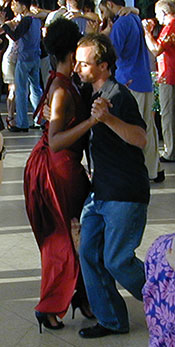
How much to lean
Ming Mar wrote:
"...In those days women here were taught to lean forward
or to push against their partners. Unfortunately they
weren't told how much of a lean nor how much of a
push. The result was that men ended up with sore
arms, sore backs, and being destabilized. I
complained to Hernán about it, and he said that, yes,
it was a big problem here. I asked him what I could
do to protect my back. He said that after the dance I
should say, "Gracias. Hasta la próxima vida."
If it did not work - you did not do it right. The correct lean is going to protect your back. Let us see..
How much to lean? To begin with, make a small distance between you and your partner. Boldly lean against each other. It varies, but the best is if you touch with the area from abdomen to chest. May be a little to the side if it is more comfortable. Knees are little bend. You should push a little with you legs from the floor into your partner chest. Into the chest: arms are free. Not hanging. Move yourself a little. Find most comfortable position. It should be much easier and lighter then you stand on your own. The feeling is as if you are resting. It is exactly the same when you lean against the wall, when you are tired.
When you step - your goal number 1 is to preserve this position. When you move - she does not step over the ball of her foot - it breaks the position and that what generates you being tired. She must preserve the lean always, on or between steps. Yes, you will fall without each other. It is not easy to separate, do not try it.
It seems to me if your back was sore, you tried to lean, but she did not. She did not provided you enough support. So you had to overtense your muscles trying to hold her and keep the position during the steps. This should not be an impression of a lean, it is a real one!
It is not the geometrical position you should keep, but the feeling of easiness and floating in space. Scientifically: "force between the chests = constant". That is the precise answer how much to lean.
If you had a sore back - you might not lean trusting each other, so you kept your muscles alert "just in case". The position should give you relaxation, not tension.
Your legs should be very precise. They step right into the right point. She should step a little back. If she does not: you can compensate stepping a little back, but that is not good. Your body, and therefore your position is moved and supported by you legs, so they should work. ( I hope it is not strange to hear :) )
When you lead, you lead with your chest....
...and so on.
Igor Polk
* * *
P.S.
The cleanest example of Apilado style dancing is this: Tango Dancers Eva Lucero and Patricio Touceda. This is Apilado !!!
Another video link: Gavito and ..
1. Some of us have to learn the dance, have to know more about it because we are very limited in our opportunities here, outside of Buenos Aires. Even in San Francisco. Many of us learn by analyzing. I do not consider tango as a dance only. It is a science for me also. Everything is a science and art.
2. Most of this text was published on the web as a part of discussion about leaning and Apilado position. Here is another message which is in my view most useful: ".. muscles around the inner axis.." by Astrid.
3. Something similar is sometimes called Carpa or Carpa position. The difference. Carpa, Gavito is a master of it, usually is large. It is kept in certain movements while Apilado is small. Just enough to create the feel of apilado. It is preserved through the whole dance. Apilado defines a style. Carpa is an element, or position for a specific group of elements.
2007.09.04 Here is another couple, Gustavo Benzecry Saba & Maria Olivera are presenting deep Apilado in Milonga as a figure. It starts at about 2:30.
* * *
P.P.S.
> Hi,
> I missed dancing with you <...> I hope you
> will be back sometime, and I hope I can still be reminded how to dance
> apilado- since I have been dancing more upright like the people around
> here since I last danced with you. I loved the feeling of dancing with you.
> N.
-<...> How can I describe it to men who do not know about it?
-Igor.
I'm not sure how to describe it to interest men. I have only experienced it with dancing as a follower. What I noticed was that my legs and feet felt very free and mobile...you were able to move them, even though I didn't really know what they were doing. The free-leg feeling was exhilerating and natural...no thinking. There is no question of "trying to be connected to the partner and the floor". You are.
I also felt very dependent on you, and very trusting...it could only work if I gave up control and was very trusting. It made us do things together; we couldn't do them alone because were depending on each other...certainly I was depending on you.
Perhaps people would be attracted to try it as something different...to experience another way to connect...in addition to the salon and own-axis embraces...then a certain percent would like it. I liked the feel of it, so followers might be interested if they felt you lead it, but I don't know how that would work for leaders. Maybe they would be interested if the followers said they liked it.
There is so much to learn about tango and so many different ideas, that
feeling the feeling helps me decide what I like much more than being
told about it...especially since there are so many opinions that differ
on what is "correct" or "ideal".
I can't reason it out, but I know what I like when I feel it.
<..>
N.
* * *
P.P.P.S.
June 9, 2007
How about those slogans: "Stay on your own axis" and "Keep your own balance"?
Steve Pastor answers:
These "slogans" : "Stay on your own axis" and "Keep your own
balance"?, are in my opinion responsible for much confusion.
When followers hear this repeatedly, and try to do it, they end
up feeling like they are not there to the leader, and often find it
difficult to feel the lead. They also have a tendency to walk away
from the leader when walking backwards.
Very good dancers can "stay on their own axis", "keep their own
balance", and still provide an adequate connection. However, in the
extreme, it is possible to be so light that the woman can't be felt in
any substantial way.
Regular dancers are almost always better off to share some weight, or
forward energy, with their partner. At the very least their weight
should be toward the leader. The more weight is shared, the closer
you get to using the label "apilado".
Tango is not dancing separately together. It is dancing together.
When I want to stay on my own axis and keep my own balance, I go line
dancing.
* * *
September 2008
Orlando Paiva Junior and Laura Tate demonstrate Apilado Tango position:
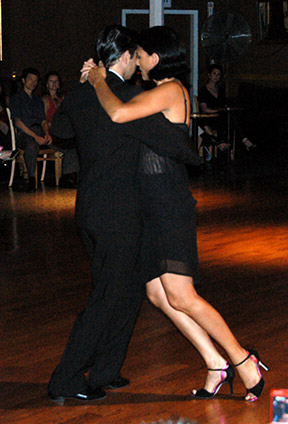
* * *
P.P.P.P.S.
2009, February 4
Latest update,
Chicho is dancing in Apilado:
Well, let my put myself for your judgment, Igor Polk and Teressa dancing Canyengue in Apilado:
